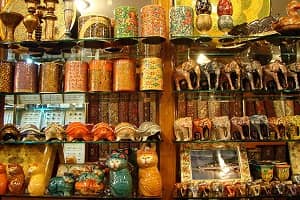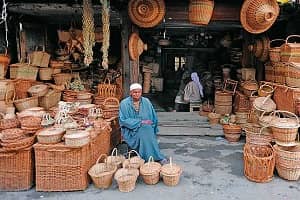Kashmir, the lovely paradise on earth, is a place that is a melting pot of cultures. People from Persia, Tibet, North Asia, Central Asia, and other parts of the world have come, been conquered by its beauty, and stayed. It is only to be expected that such ethnic diversity would also promote the culture and reflect in the arts and crafts of the region Kashmiri.
 Handicrafts are unique and some of them, like pashmina shawls, are highly prized throughout the world. Another factor that promotes extensive handicrafts apart from culture is the weather and the cold winters may partly be responsible for people staying and working indoors.
Handicrafts are unique and some of them, like pashmina shawls, are highly prized throughout the world. Another factor that promotes extensive handicrafts apart from culture is the weather and the cold winters may partly be responsible for people staying and working indoors.
Carpet-making is an arduous, time-consuming task, and Kashmir carpets, following the Persian styles, are a case in point.
Kashmir is known for its handicraft items such as carpets, shawls, silk, crewel stitched and embroidered fabrics, wood carvings in walnut wood, papier-mache products, wall hangings, silver and bronze craft, namdas or rugs, and basketry.
List Of Jammu and Kashmir Handicrafts?
There is a list of Kashmir Handicrafts skills that we have described below in detail. To know more read this carefully.
Kashmiri Shawls
This craft has been in existence for centuries and received a boost during the Mughal rule, ascribed to Emperor Akbar’s fondness for this raiment. At the basic level, you can find affordable woolen shawls, distinguished by the use of pure wool and exquisite embroidery work.
Pashmina shawls, for which Kashmir is so famous, are definitely a step up. Hair of the rare mountain Ibex, found in high altitudes of Ladakh, is used to make these shawls. These pashmina shawls when embroidered exquisitely, can be quite expensive.
You can find cheaper versions with blends of rabbit hair and lamb wool. A full-length, completely pashmina is known as “Jamawar” and becomes a family heirloom. This is not the last word in shawls. Beyond, you have the Shahtoosh, said to be so fine, it can pass through a ring.
The hair of the Tibetan antelope is used to make shahtoosh that commands fabulous prices. The cost is because only hair from around the throat region shed by antelopes while grazing is used. Collecting this hair is a painstaking process, and it takes a long time to put together sufficient quantities.
Kashmiri Silk
Silkworms are grown on mulberry trees that grow in the valley and yarn is produced from cocoons. Yarn is used to make sarees and garments but a major portion goes into the making of Kashmiri Carpets.
Kashmiri Carpets
Carpets came to Kashmir from Persia and unique to Kashmiri carpets is that they are knotted, not tufted as is done elsewhere. The Persian origins can be seen in the designs woven into the carpets. Carpets made here use silk or wool or a mixture of both knotted into a base fabric.
The higher the number of knots per square inch, the richer it is with a rich, piled, texture. Kashmiri carpets can be light and muted in colors but the single or double knotted characteristics give them value and make them a highly prized product worldwide.
Crewel Fabrics
This is yet another outstanding handicraft of Kashmir. A crewel is a distinctive form of embroidery done using chain stitches with a pointed hook to form a solid, thick pattern that gives an embossed effect. Kashmiri designs are typically floral and maybe muted pastels or richly colored in vivid hues.
The underlying fabric is thick cotton, linen, or even jute, and the yarn used for embroidery is usually wool. Crewel fabrics are used for cushion covers, duvets, bed sheets, curtains, and furnishings, widely popular across the world rather than in India.
Papier Mache
Papier-mache products are made of paper pulp mash mixed with glue and cast into moulds. Such products are light in weight, can be given any form or shape, and are rigid and tough too. What distinguishes Kashmiri papier mache is the elaborate paintings on the papier machine products.
Expensive papier machine articles may have intricate paintings done by artists and may even involve the use of pure gold powder in the paint. Vases, boxes, frames, and figurines are just a few of the products made using papier mache, with a typical Persian or Arab flavor in design as well as paint and choice of color combinations.
Namdas
Namdas are like rugs. What differentiates Kashmiri Namdas is that they are not woven or knotted but are made by felting or layering wool or wool and cotton mix or even acrylic fiber followed by rich embroidery to make it colorful and appealing.
Basketry
 Craftsmen of Kashmir have developed unique geometries and use locally available material growing in water bodies to weave baskets. Willow is a favorite material as is bamboo and Kashmiri designs are quite distinctive as compared to those from the south or northeast.
Craftsmen of Kashmir have developed unique geometries and use locally available material growing in water bodies to weave baskets. Willow is a favorite material as is bamboo and Kashmiri designs are quite distinctive as compared to those from the south or northeast.
Carvings
Walnut wood is the choice of material for a variety of wood carvings made in Kashmir, ranging from statues and figurines to objects of everyday use and furniture.
The most highly prized walnut wood carvings are almost black in color, made from walnut wood sourced from the tree’s root. Carvings generally use flower and natural motifs as well as latticework. Walnut wood carvings of Kashmir are not varnished but are waxed to bring out the smooth grain.
Copper and Silver Ware
Kashmiri silverware is exquisite, reminiscent of something out of the Arabian Nights, with its unique floral motifs. You can find hand-beaten samovars, plates, and other utensils made of copper but with unique shapes and engravings of floral motifs.
You can find engraved or even embossed articles and copper vessels with inlay and enamel work that serve functional purposes while being highly aesthetic.
If and when you do visit Kashmir, you will have a hard time deciding which mementos to pick as souvenirs of your trip given the richness and depth of crafts here.
If you can afford it, a pashmina should be high on your list or it could be an exquisite carpet that will last for generations. At the very least you could pick up a couple of silverware or walnut carvings and some crewel fabrics.

 Call
Call WhatsApp
WhatsApp Enquiry
Enquiry